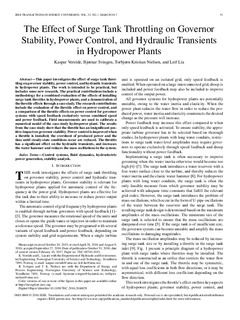The Effect of Surge Tank Throttling on Governor Stability, Power Control, and Hydraulic Transients in Hydropower Plants
Journal article, Peer reviewed
Published version
Permanent lenke
http://hdl.handle.net/11250/2474375Utgivelsesdato
2017Metadata
Vis full innførselSamlinger
Originalversjon
IEEE transactions on energy conversion. 2017, 32 (1), 91-98. 10.1109/TEC.2016.2614829Sammendrag
This paper investigates the effect of surge tank throttling on governor stability, power control, and hydraulic transients in hydropower plants. The work is intended to be practical, but includes some new research. The practical contributions include a methodology for a combined evaluation of the effects of installing surge tank throttles in hydropower plants, and a demonstration of the throttle effects through a case study. The research contributions include the evaluation of the throttle effect on power control, and a comparison of the throttle effects on power control for governor systems with speed feedback exclusively versus combined speed and power feedback. Field measurements are used to calibrate a numerical model of the case-study hydropower plant. The results from the case study show that the throttle has an insignificant positive impact on governor stability. Power control is improved when a throttle is installed; the overshoot of produced power and the time until steady-state conditions occur are reduced. The throttle has a significant effect on the hydraulic transients, and increases the water hammer and reduces the mass oscillations in the system.
